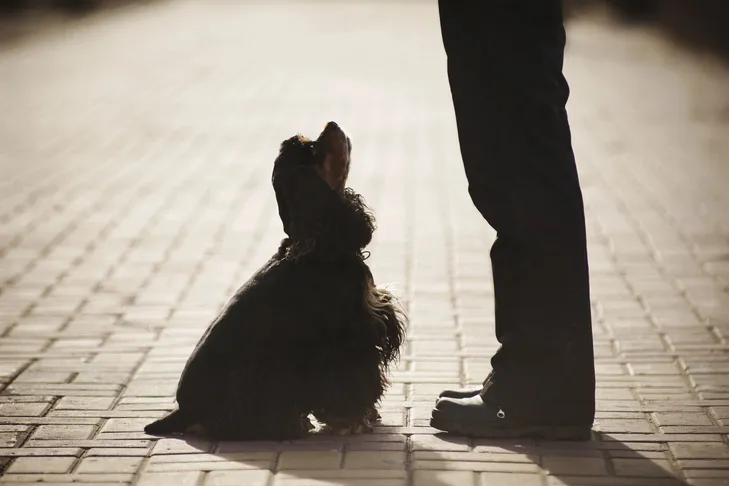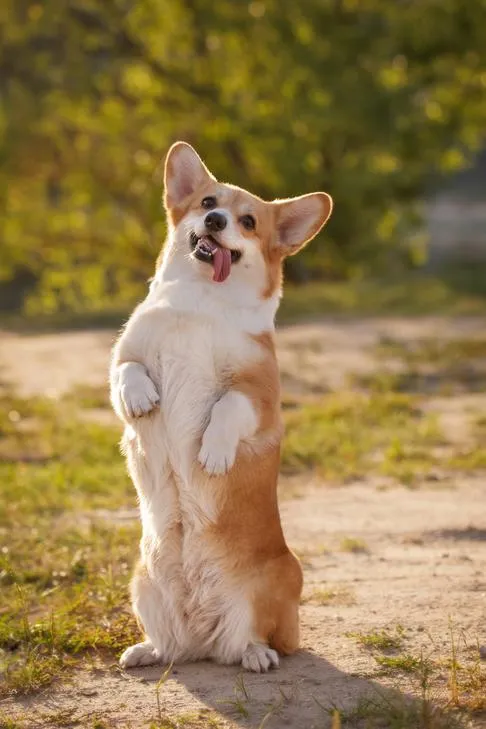Teaching your dog to sit is one of the foundational commands in dog training, and for good reason. A solid “sit” can be an invaluable tool, helping to manage your dog’s energy, prevent unwanted behaviors like jumping, and build a stronger bond between you and your canine companion. Many dog owners, however, find themselves frustrated when their dogs struggle to master this basic command, often popping up too quickly or refusing to sit at all. If you’re facing these challenges, or simply looking to refine your dog’s sitting skills, this guide will provide you with effective techniques and insights to achieve a reliable sit. For those seeking to address other common behavioral issues, learning how to stop your dog from jumping up on visitors can also be a crucial step in their training journey.
Mastering the “Sit” Command: Step-by-Step Training
The most effective and widely adopted method for teaching a dog to sit involves lure and reward training, utilizing a handful of your dog’s favorite, high-value treats. A clicker can be an excellent addition to your training toolkit, allowing you to precisely mark the exact moment your dog performs the desired behavior – sitting. To maximize your chances of success, it’s best to conduct training sessions when your dog is relaxed and in an environment with minimal distractions, ensuring they can focus solely on learning.
The Lure and Reward Technique
- Initiate the Lure: With your dog standing in front of you, hold a treat close to their nose.
- Guide the Movement: Slowly move the treat upwards and slightly back over your dog’s head, towards their rear. As your dog naturally follows the treat with their nose, their hindquarters should begin to lower towards the ground.
- Mark and Reward: The instant your dog’s rear end touches the floor in a sitting position, click your clicker (if using one) and/or offer immediate verbal praise. Follow this with the treat as a positive reinforcement.
- Reset and Repeat: To encourage your dog to stand again, you can either walk a few steps away and call them, or toss another treat a short distance. Once they are standing, repeat steps 1-3.
- Fade the Lure: Once your dog reliably follows the treat into a sit, it’s time to gradually reduce your reliance on the treat as a visual lure. Begin by using an empty hand to perform the same luring motion. Reward the successful sit with a treat from your other hand. This movement of your empty hand will soon become your hand signal for “sit.”
- Introduce the Verbal Cue: When your dog consistently sits in response to your empty hand signal, start introducing the verbal cue, such as “sit,” just before you give the hand signal. With consistent practice, your dog will eventually learn to respond to the verbal cue alone.
It is crucial to avoid physically pushing your dog’s hindquarters down, as this can be intimidating and confusing for them. Always ensure you present the treat while your dog is in the sitting position to clearly reinforce that specific posture. If you wait until they stand up again, or inadvertently lure them back to standing while searching for a treat, you may inadvertently encourage them to pop up immediately after sitting.

If your dog is having difficulty grasping the concept, you can also adapt the lure from a down position. Begin with your dog lying down, and then shape their behavior incrementally towards a sit. Hold a treat at their nose, and slowly raise it, clicking and rewarding any upward movement of their head. Gradually increase the height you raise the treat with each repetition, encouraging them to lift their chest and eventually transition into a sit.
Another highly effective method is “capturing” a sit. This involves rewarding your dog whenever they naturally sit on their own. By consistently clicking, praising, and rewarding these spontaneous sits, your dog will begin to associate sitting with positive outcomes and may start offering sits more frequently. When you notice your dog is about to sit, you can introduce your verbal cue “sit” just before they do it, further strengthening the association. This proactive approach can be incredibly beneficial, especially if you’re also working on teaching how to stop your puppy jumping on the sofa.
Making “Sit” a Default Behavior
Developing “default behaviors” means encouraging your dog to perform certain actions voluntarily, without needing a direct cue from you. Wouldn’t it be ideal if your dog chose to sit rather than jump or dash around the house? The more you practice the “sit” command in various training scenarios, the more likely your dog will be to offer a sit in everyday situations. To truly solidify this, it’s essential to reward your dog for sitting whenever they do it on their own.

For instance, if your dog approaches you and sits, offer praise and a treat. Similarly, if they sit while you’re preparing their food, reward that behavior. Initially, you might need to prompt them with the “sit” cue, but with repeated positive reinforcement, they will start offering sits independently. Don’t underestimate the power of these moments! Use whatever rewards are most motivating for your dog – a tasty treat, a game of tug, or a favorite toy. Over time, your dog will begin to offer sits as a polite way of requesting something, essentially saying “please.” This foundation is crucial, particularly when dealing with energetic puppies, and understanding how do you stop a puppy jumping up can complement the “sit” command effectively.
Adding an Adorable Trick: “Sit Pretty”
Once your dog has mastered a reliable “sit,” you can move on to teaching the charming trick “sit pretty“. This involves your dog sitting on their haunches with their front paws lifted in the air, resembling a begging pose. It’s an undeniably cute trick that is surprisingly easy to train.

Here’s how to teach your dog to “sit pretty”:
- Start with a Sit: Ask your dog to perform their regular “sit” command.
- Lure Upwards: Once sitting, hold a treat near their nose and slowly lift it upwards. Your dog will naturally rise on their hind legs to follow the treat. The moment their front paws leave the ground, click and/or praise, and reward.
- Increase the Height: Repeat step 2, but raise the treat slightly higher each time. This encourages your dog to lift their front paws even further. Continue this progression until they are holding the classic “sit pretty” position.
- Fade the Lure: Once your dog reliably lifts into the sit-pretty position with the treat lure, transition to using an empty hand for the same motion. This empty hand will become your new hand signal for the trick. Continue to reward them for successful sits.
- Introduce the Verbal Cue: With your dog responding to the hand signal, introduce a verbal cue such as “sit pretty” or “beg” just before you give the hand signal. Over time, they should respond to the verbal cue alone.
If your dog struggles with balance, you can offer your forearm as a temporary support for their front paws until they gain confidence and learn to hold themselves up. With a little practice, your dog will not only have a solid foundation in the “sit” command but also an adorable new trick to show off! For those who find their dogs exhibiting aggressive tendencies, seeking professional guidance on how to train an aggressive dog with other dogs is essential.
References
- American Kennel Club. (n.d.). How to Stop Your Dog from Jumping Up on People. Retrieved from https://www.akc.org/expert-advice/training/how-to-stop-your-dog-from-jumping-up-on-people/
- American Kennel Club. (n.d.). Lure-Reward Training Your Dog. Retrieved from https://www.akc.org/expert-advice/training/lure-reward-training-dogs/
- American Kennel Club. (n.d.). Clicker Training Your Dog: Mark and Reward. Retrieved from https://www.akc.org/expert-advice/training/clicker-training-your-dog-mark-and-reward/
- American Kennel Club. (n.d.). Training Dogs to Ignore Distractions. Retrieved from https://www.akc.org/expert-advice/training/training-dogs-to-ignore-distractions/
- American Kennel Club. (n.d.). Training Rewards. Retrieved from https://www.akc.org/expert-advice/training/training-rewards/
- American Kennel Club. (n.d.). How to Fade the Lure. Retrieved from https://www.akc.org/expert-advice/training/how-to-fade-the-lure/
- American Kennel Club. (n.d.). Understanding Your Dog Can Make You a Better Trainer. Retrieved from https://www.akc.org/expert-advice/training/understanding-your-dog-can-make-you-a-better-trainer/
- American Kennel Club. (n.d.). How to Use Verbal Commands. Retrieved from https://www.akc.org/expert-advice/training/how-use-verbal-commands/
- American Kennel Club. (n.d.). How to Teach Your Dog to Lie Down. Retrieved from https://www.akc.org/expert-advice/training/how-to-teach-your-dog-to-lie-down/
- American Kennel Club. (n.d.). Training Tips: Shaping. Retrieved from https://www.akc.org/expert-advice/training/training-tips-shaping/
- American Kennel Club. (n.d.). Dog Tug-of-War: Dog Myths Debunked. Retrieved from https://www.akc.org/expert-advice/lifestyle/dog-tug-of-war-dog-myths-debunked/
- American Kennel Club. (n.d.). Teach Dog to Sit Pretty. Retrieved from https://www.akc.org/expert-advice/training/teach-dog-sit-pretty/
- American Kennel Club. (n.d.). Trick Dog. Retrieved from https://www.akc.org/sports/trick-dog/
